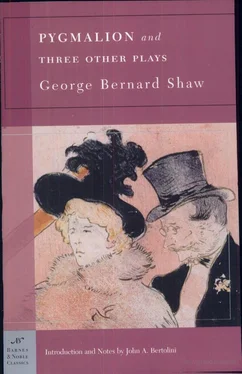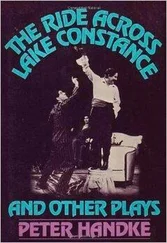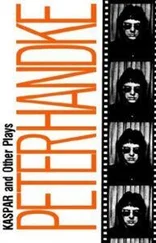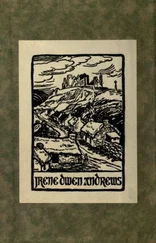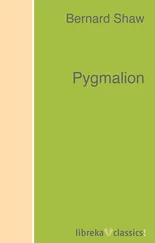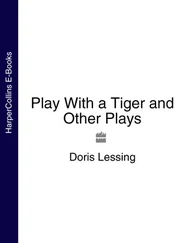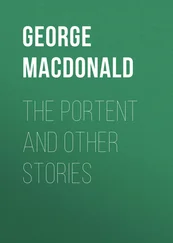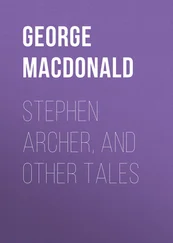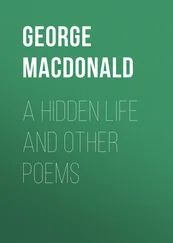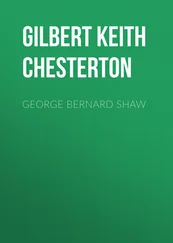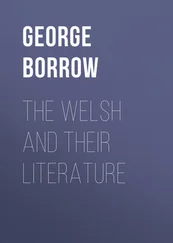9 (p. 524) “It has been a very unpleasant surprise to me to find that nobody expects me”: It is a common motif in dreams that one arrives at a place where one is not known or expected. Heartbreak House begins with Ellie’s falling asleep, and with Nurse Guinness’s just managing to prevent a crash of bottles to the floor. These two actions frame the play as a circular dream: The entire play may be seen as Ellie’s dream; at the end of the play, the motif of the bottles that do not fall is replicated on a grander scale by the house’s escaping destruction.
10 (p. 596) “it’s like the night in Tristan and Isolde”: In Wagner’s opera Tristan und Isolde (1859), the lovers are drawn to the night as the realm where a true and complete union can take place between them.
11 (p. 611) “Fall and crush”: Hector echoes Albany’s line, “Fall, and cease” in the last scene of Shakespeare’s King Lear. As Albany sees the ancient Lear carrying in Cordelia’s murdered body, he expresses his sense that the world should collapse and end in the face of such evil. Likewise, through Hector’s sense of futility here, Shaw is expressing his own anger at the carnage and stupidity of a world gone war-mad between 1914 and 1918.
12 (p. 624) “Stop, Ellie; or I shall howl like an animal”: Through Hesione’s near-breakdown, Shaw is alluding (again) to the final scene of King Lear, when Lear enters with the body of Cordelia in his arms and commands everyone to “Howl, howl, howl.” Lear is reduced to a grieving animal howling out its raw pain. It is such grief over the cataclysm of the war that keeps threatening to break through the surface of the play, as here in Hesione’s attempt to suppress her despair.
13 (p. 625) “Was there no heartbreak in that for your father?”: Shotover’s humiliation here in the confession of how his daughter Addy’s leaving home broke his heart shows how deeply Shaw has embedded King Lear in Heartbreak House; just as Lear’s denial of his own mortality manifests itself in his incestuous impulse to keep his daughter Cordelia to himself, so too does Captain Shotover’s resistance to crashing the ship of state on the rocks manifest itself in his spiritual marriage to Ellie, who, as befits the dream-like state of the action, can be both his daughter and his wife. The issue of Ellie’s marrying the older Mangan, a man her adored father’s age, is Shaw’ s version of the first part of King Lear, where Cordelia must first reject her father’s demands on her.
INSPIRED BY PYGMALION AND THREE OTHER PLAYS
My Fair Lady, with book and lyrics by Alan Jay Lerner and music by Frederick Loewe, opened on Broadway on March 15, 1956, to overwhelming applause from audiences and critics alike. The original production starred Rex Harrison as Henry Higgins and the incandescent Julie Andrews as Eliza Doolittle. Eliza gets things started memorably with “Wouldn’t It Be Loverly?” in which she daydreams for a “room somewhere / far away from the cold night air.”The roster of songs, which all became hits, includes “Just You Wait,” “I Could Have Danced All Night,” “On the Street Where You Live,” and “I’ve Grown Accustomed to Her Face.”
Lerner and Loewe had attempted to turn Pygmalion into a musical in 1952 but found the task impossible. For this production they made several cuts to Shaw’s drama, most conspicuously changing Shaw’s ending into an unambiguously happy one. At the beginning of the libretto, Lerner inserted the phrase, “I have omitted [Shaw’s epilogue] because in it Shaw explains how Eliza ends not with Higgins but with Freddy and — Shaw and Heaven forgive me! — I am not certain he is right.”Thus My Fair Lady closes with Higgins’s famous: “Eliza? Where the devil are my slippers?”
My Fair Lady quickly became a phenomenon in American thea ter. The Broadway production was a great commercial success, earned ten Tony nominations, and has been called the greatest stage musical of all time. On June 13, 1961, My Fair Lady beat out Rodgers and Hammerstein’s Oklahoma! as history’s longest-running Broadway play, and the best-selling original cast recording is still in demand. At the 1957 Tony Awards, Harrison earned a statue for his performance, and Andrews was nominated for hers (she spent a total of forty-eight months playing Eliza on the stage). My Fair Lady also won Tonys for best director (Moss Hart), best conductor and musical director (Franz Allers), best scenic designer (Oliver Smith), best costume designer (Cecil Beaton), and best musical.
Part of My Fair Lady’s commercial success was the multimillion dollar sale of the movie rights. George Cukor (The Philadelphia Story and David Copperfield) directed the lavish screen adaptation, produced by movie mogul Jack L. Warner. Rex Harrison reprised his stage role as phonetics professor Henry Higgins, and Audrey Hepburn replaced Julie Andrews, with songs voiced by Marni Nixon (who also sang Natalie Wood’s part in West Side Story). The 1964 film opens with a dazzling sequence of close-ups of flowers lining a brilliantly recreated Covent Garden Opera House. Hepburn’s waifish and unwashed Eliza stands by, selling flowers to the fabulously dressed, upper-class operagoers. Without delay, Harrison sidles up and begins to abuse Hepburn for her deplorable accent, giving vent to barbed dialogue that is indebted to Shaw’s original. Some of the more acerbic insults include “A woman who utters such disgusting and depressing noise has no right to be anywhere, no right to live,” and “Don’t sit there crooning like a bilious pigeon.” So begins one of cinema’s most intelligent romances, one in which the principal players neither touch nor kiss.
Cukor’s My Fair Lady was nominated for twelve Academy Awards. The film earned Oscars for best actor (Harrison); director; cinematography and color (Harry Stradling); art and set direction; sound; music and score adaptation (Andre Previn); and costume design (Cecil Beaton), as well as best picture. Oddly enough, Julie Andrews, who is generally agreed to be sorely missing from Cukor’s film, won the best actress Oscar for her performance in that year’s Mary Poppins.
The stage success of My Fair Lady in New York and London inspired MGM to produce a lavish widescreen film of The Doctor‘s Dilemma (1958). Directed by Anthony Asquith (who had co-directed with Leslie Howard the highly successful 1938 film of Pygmalion), it stars Dirk Bogarde and Leslie Caron, and features the experienced Shavian actors Robert Morley and Alastair Sim, who play two incompetent doctors with great comedic zest and skill.
Major Barbara was memorably filmed in 1941 while German bombs fell on London, inconveniencing the production greatly. The director of record is Gabriel Pascal, but the editor, David Lean, seems to have had a large part in putting the film together. Wendy Hiller, who effectively created the role of Eliza Doolittle on screen three years earlier, plays Barbara. Rex Harrison is an attractive Cusins, while Robert Morley makes a delightfully devilish Undershaft.
Heartbreak House has never been filmed, but Rex Harrison and Amy Irving starred in an excellent television adaptation in 1986. Harrison as Captain Shotover proves himself once again the premier Shavian actor of his time, while Amy Irving finds the emotional depth Shaw meant the role of Ellie to have.
In this section, we aim to provide the reader with an array of perspectives on the text, as well as questions that challenge those perspectives. The commentary has been culled from sources as diverse as reviews contemporaneous with the works, letters written by the author, literary criticism of later generations, and appreciations written throughout the works’ history. Following the commentary, a series of questions seeks to filter George Bernard Shaw’s Pygmalion and Three Other Plays through a variety of points of view and bring about a richer understanding of these enduring works.
Читать дальше
